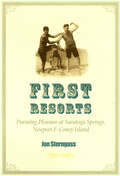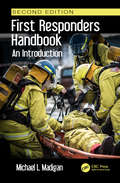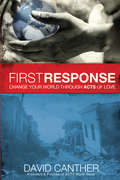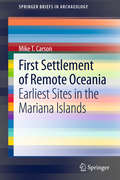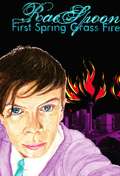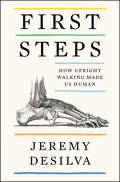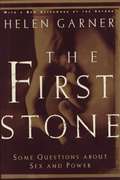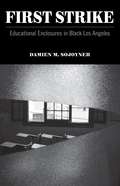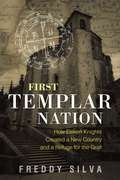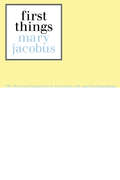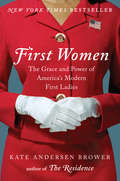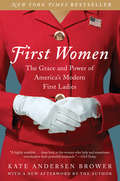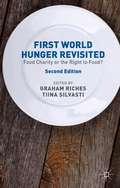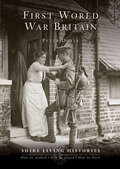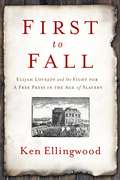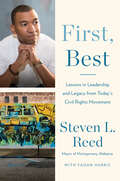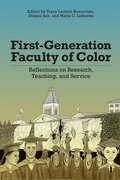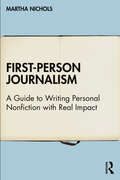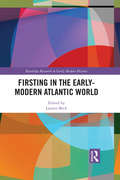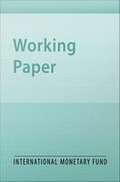- Table View
- List View
First Resorts: Pursuing Pleasure at Saratoga Springs, Newport & Coney Island
by Jon Sterngass“[A] scrupulously researched and beautifully crafted account of how nineteenth-century Americans went in search of health, rest, and diversion.” —Lena Lencek and Gideon Bosker, coauthors of The Beach. The History of Paradise on EarthIn First Resorts: Pursuing Pleasure at Saratoga Springs, Newport, and Coney Island, Jon Sterngass follows three of the best-known northeastern American resorts across a century of change. Saratoga Springs, Newport, and Coney Island began, he finds, as similar pleasure destinations, each of them featuring “grand” hotels where visitors swarmed public spaces such as verandas, dining rooms, and parlors. As the century progressed, however, Saratoga remained much the same, while Newport turned to private (and lavish) “cottages” and Coney Island shifted its focus to amusements for the masses.Fifty-nine illustrations enliven Sterngass’s unique study of the commodification of pleasure that occurred as capitalist values flourished, travel grew more accessible, and leisure time became democratized. These three resorts, he argues, served as forerunners of twentieth-century pleasure cities such as Aspen, Las Vegas, and Orlando.“An engaging, creative book replete with evocative illustrations and witty quotes . . . a pleasant read.” —Thomas A. Chambers, New York Academy of History“Sterngass’s discussions about privacy, community, commercialization, consumption, leisure, and the desire to be conspicuous are important and new. With its well-chosen illustrations, this is a handsome book as well as an important one.” —Kathryn Allamong Jacob, Radcliffe Institute for Advanced Study, Harvard University“Having mined every conceivable source about his three sites, Sterngass has presented a wealth of interesting material not only about the resort experience but also about the residents, politicians, and entrepreneurs who built them.” —Journal of American History
First Responders Handbook: An Introduction
by Michael MadiganThe objective of this handbook is to make available in a quick reference form, the information to enhance and support the response capabilities of firefighters, emergency medical technicians, hazardous materials response teams, law enforcement officers, bomb squads, medical doctors and nurses, emergency managers, schools, and others. This handbook is dedicated and committed to disaster prevention, preparedness, readiness, response, mitigation and recovery efforts. This is an ideal book for newcomers to the field, and can be used for fast knowledge for application to any areas of response.
First Response: Change Your World Through Acts of Love
by Mr. David Mark CantherACTS World Relief founder David Canther shares how acts of kindness and meeting the needs of people can touch the world with God’s love. These anecdotes illustrate what Jesus lived every day--to love and serve God and others. Readers will discover how to become a first responder by meeting the needs of others first, and see the world change.
First Settlement of Remote Oceania: Earliest Sites in the Mariana Islands
by Mike T. CarsonThis book offers the only synthesis of early-period Marianas archaeology, marking the first human settlement of Remote Oceania about 1500 B.C. In these remote islands of the northwest Pacific Ocean, archaeological discoveries now can define the oldest site contexts, dating, and artifacts of a Neolithic (late stone-age) people. This ancient settlement was accomplished by the world's longest open-ocean voyage in human history at its time, more than 2000 km from any contemporary populated area. This work brings the isolated Mariana Islands into the forefront of scientific research of how people first settled Remote Oceania, further important for understanding long-distance human migration in general. Given this significance, the early Marianas sites deserve close attention that has been awkwardly missing until now. The author draws on his collective decades of intensive field research to define the earliest Marianas sites in scientific detail but accessible for broad readership. It covers three major topics: 1) situating the ancient sites in their original environmental contexts; 2) inventory of the early-period sites and their dating; and 3) the full range of pottery, stone tools, shell ornaments, and other artifacts. The work concludes with discussing the impacts of their findings on Asia-Pacific archaeology and on human global migration studies.
First Spring Grass Fire
by Rae SpoonTransgender indie electronica singer-songwriter Rae Spoon has six albums to their credit, including 2012's I Can't Keep All of Our Secrets. This first book by Rae (who uses "they" as a pronoun) is a candid, powerful story about a young person growing up queer in a strict Pentecostal family in rural Canada.The narrator attends church events and Billy Graham rallies faithfully with their family before discovering the music that becomes their salvation and means of escape. As their father's schizophrenia causes their parents' marriage to unravel, the narrator finds solace and safety in the company of their siblings, in their nascent feelings for a girl at school, and in their growing awareness that they are not the person their parents think they are. With a heart as big as the prairie sky, this is a quietly devastating, heart-wrenching coming-of-age book about escaping dogma, surviving abuse, finding love, and risking everything for acceptance.Rae Spoon lives in Montreal, Quebec.
First Steps: How Upright Walking Made Us Human
by Jeremy DeSilvaA Science News Best Science Book of the Year: “A brilliant, fun, and scientifically deep stroll through history, anatomy, and evolution.” —Agustín Fuentes, PhD, author of The Creative Spark: How Imagination Made Humans ExceptionalWinner of the W.W. Howells Book Prize from the American Anthropological AssociationBlending history, science, and culture, this highly engaging evolutionary story explores how walking on two legs allowed humans to become the planet’s dominant species.Humans are the only mammals to walk on two rather than four legs—a locomotion known as bipedalism. We strive to be upstanding citizens, honor those who stand tall and proud, and take a stand against injustices. We follow in each other’s footsteps and celebrate a child’s beginning to walk. But why, and how, exactly, did we take our first steps? And at what cost? Bipedalism has its drawbacks: giving birth is more difficult and dangerous; our running speed is much slower than other animals; and we suffer a variety of ailments, from hernias to sinus problems.In First Steps, paleoanthropologist Jeremy DeSilva explores how unusual and extraordinary this seemingly ordinary ability is. A seven-million-year journey to the very origins of the human lineage, this book shows how upright walking was a gateway to many of the other attributes that make us human—from our technological abilities to our thirst for exploration and our use of language—and may have laid the foundation for our species’ traits of compassion, empathy, and altruism. Moving from developmental psychology labs to ancient fossil sites throughout Africa and Eurasia, DeSilva brings to life our adventure walking on two legs.Includes photographs“A book that strides confidently across this complex terrain, laying out what we know about how walking works, who started doing it, and when.” —The New York Times Book Review“DeSilva makes a solid scientific case with an expert history of human and ape evolution.” —Kirkus Reviews“A brisk jaunt through the history of bipedalism . . . will leave readers both informed and uplifted.” —Publishers Weekly“Breezy popular science at its best.” —Science News
First Stone: Some Questions about Sex and Power
by Helen GarnerHelen Garner delves into the causes and effects of police charges pressed against the Master of Ormond College by two female students who claimed he fondled them at a school function. Two overriding questions trouble Ms. Garner throughout her investigations: why did these students choose to go to the police instead of having the matter settled through the school's private arbitration process, and why, when the Master was found innocent of these charges, was he terminated from his position? The First Stone is a call for hard-line feminists to grow up and get conscious. It asks for a new kind of feminism based on the cultivation of an individual's power of self-expression, responsibility, and, indeed, exactly the kind of self-discovery her insightful narrative represents.
First Strike: Educational Enclosures in Black Los Angeles
by Damien M. SojoynerCalifornia is a state of immense contradictions. Home to colossal wealth and long portrayed as a bastion of opportunity, it also has one of the largest prison populations in the United States and consistently ranks on the bottom of education indexes. Taking a unique, multifaceted insider&’s perspective, First Strike delves into the root causes of its ever-expansive prison system and disastrous educational policy. Recentering analysis of Black masculinity beyond public rhetoric, First Strike critiques the trope of the &“school-to-prison pipeline&” and instead explores the realm of public school as a form of &“enclosure&” that has influenced the schooling (and denial of schooling) and imprisonment of Black people in California. Through a fascinating ethnography of a public school in Los Angeles County, and a &“day in the life tour&” of the effect of prisons on the education of Black youth, Damien M. Sojoyner looks at the contestation over education in the Black community from Reconstruction to the civil rights and Black liberation movements of the past three decades. Policy makers, school districts, and local governments have long known that there is a relationship between high incarceration rates and school failure. First Strike is the first book that demonstrates why that connection exists and shows how school districts, cities and states have been complicit and can reverse a disturbing and needless trend. Rather than rely upon state-sponsored ideological or policy-driven models that do nothing more than to maintain structures of hierarchal domination, it allows us to resituate our framework of understanding and begin looking for solutions in spaces that are readily available and are immersed in radically democratic social visions of the future.
First Templar Nation: How Eleven Knights Created a New Country and a Refuge for the Grail
by Freddy SilvaOverturns the long-established historical narrative about the origins and purpose of the Knights Templar • Explains how and why the Templars created Europe’s first nation-state, Portugal, with one of their own as king • Reveals the Portuguese roots of key founding members, their relationship with the Order of Sion, the Templars’ devotion to Mary Magdalene and John the Baptist, and the meaning and exact location of the Grail • Provides evidence of Templar holy sites and hidden chambers throughout Portugal • Includes over 700 references, many from new and rare sources Conventional history claims that nine men formed a brotherhood called the Knights Templar in Jerusalem in 1118 to provide protection for pilgrims traveling to the Holy Land. Overturning this long-established historical narrative, Freddy Silva shows that the Order of the Temple existed a decade earlier on the opposite side of Europe, that the protection of pilgrims was entrusted to a seperate organization, and that, in league with the Cistercian monks and the equally mysterious Order of Sion, the Templars executed one of history’s most daring and covert plans: the creation of Europe’s first nation-state, Portugal, with one of their own as king. Including over 700 references, many from new and rare sources, Silva reveals Portugal, not Jerusalem, as the first Templar stronghold. He shows how there were eleven founding members and how the first king of Portugal, a secret Templar, was related to Bernard de Clairvaux, head of the Cistercians. The author explains the Templars’ motivation to create a country far from the grasp of Rome, where they could conduct their living resurrection initiation--whose candidates were declared “risen from the dead”--a secret for which the Church silenced millions and which the Templars protected to the death. Placing the intrepid Knights in a previously unknown time and place, Silva’s historical narrative reveals the Portuguese roots of key founding members, their relationship with the Order of Sion, the Templars’ unshakeable devotion to Mary Magdalene and John the Baptist, and how they protected a holy bloodline in Portugal. He also provides evidence of secret Templar holy sites, initiation chambers, and hidden passageways throughout Portugal, often coinciding with pagan and Neolithic temples, and explains how their most important site forms a perfect triangle with the Abbey of Mont Sion in Jerusalem and the Osirion temple in Egypt. The author also reappraises the meaning of the Grail and reveals its exact location, hidden in plain sight to this very day.
First Things: Reading the Maternal Imaginary
by Mary JacobusIn First Things Mary Jacobus combines close readings with theoretical concerns in an examination of the many forms taken by the mythic or phantasmic mother in literary, psychoanalytic and artistic representations. She carefully explores the ways in which the maternal imaginary informs both unconscious processes and signifying practices at all levels. Her fierce analysis of specific texts and paintings raises questions about the the symbolic and biological maternal body and how they relate to each other in literary and psychoanalytic terms. The invocation of writings by Kleist, Wollstonecraft, Mary Shelley, Malthus and de Sade, along with analysis of French revolutionary iconography and Realist and Impressionist paintings by Eakins and Morisot, make this wide-ranging text a truly interdisciplinary study. First Things sees literary theory and psychoanalysis as mutually illuminating practices. The work of Freud, Klein, Kristeva and Bion shape an inquiry into such topics as population discourse, surrogate motherhood, AIDS, mastectomy and psychoanalysis itself. In addition, Jacobus elaborates on Freud's oedipal preconceptions, Klein's missing theory of signs, memory, melancholia, narcissism and maternal reverie.
First Women: The Grace and Power of America's Modern First Ladies
by Kate Andersen Brower<P>From the #1 New York Times bestselling author of the groundbreaking backstairs look at the White House, The Residence, comes an intimate, news-making look at the true modern power brokers at 1600 Pennsylvania Avenue: the First Ladies, from Jackie Kennedy to Michelle Obama. <P>One of the most underestimated--and challenging--positions in the world, the First Lady of the United States must be many things: an inspiring leader with a forward-thinking agenda of her own; a savvy politician, skilled at navigating the treacherous rapids of Washington; a wife and mother operating under constant scrutiny; and an able CEO responsible for the smooth operation of countless services and special events at the White House. Now, as she did in her smash #1 bestseller The Residence, former White House correspondent Kate Andersen Brower draws on a wide array of untapped, candid sources--from residence staff and social secretaries to friends and political advisers--to tell the stories of the ten remarkable women who have defined that role since 1960. <P>Brower offers new insights into this privileged group of remarkable women, including Jacqueline Kennedy, Lady Bird Johnson, Patricia Nixon, Betty Ford, Rosalynn Carter, Nancy Reagan, Barbara Bush, Hillary Clinton, Laura Bush, and Michelle Obama. The stories she shares range from the heartwarming to the shocking and tragic, exploring everything from the first ladies' political crusades to their rivalries with Washington figures; from their friendships with other first ladies to their public and private relationships with their husbands. She also offers a detailed and insightful new portrait of one of the most-watched first ladies of all time, Hillary Clinton, asking what her tumultuous years in the White House may tell us about her own historic presidential run . . . and what life could be like with the nation's first First Husband. <P>Candid and illuminating, this first group biography of the modern first ladies provides a revealing look at life upstairs and downstairs at the world's most powerful address. <P><b>A New York Times Bestseller</b>
First Women: The Grace and Power of America's Modern First Ladies
by Kate Andersen BrowerFrom the #1 New York Times bestselling author of the groundbreaking backstairs look at the White House, The Residence, comes an intimate, news-making look at the true modern power brokers at 1600 Pennsylvania Avenue: the First Ladies, from Jackie Kennedy to Michelle Obama and Melania Trump.One of the most underestimated—and challenging—positions in the world, the First Lady of the United States must be many things: an inspiring leader with a forward-thinking agenda of her own; a savvy politician, skilled at navigating the treacherous rapids of Washington; a wife and mother operating under constant scrutiny; and an able CEO responsible for the smooth operation of countless services and special events at the White House. Now, as she did in her smash #1 bestseller The Residence, former White House correspondent Kate Andersen Brower draws on a wide array of untapped, candid sources—from residence staff and social secretaries to friends and political advisers—to tell the stories of the ten remarkable women who have defined that role since 1960.Brower offers new insights into this privileged group of remarkable women, including Jacqueline Kennedy, Lady Bird Johnson, Patricia Nixon, Betty Ford, Rosalynn Carter, Nancy Reagan, Barbara Bush, Hillary Clinton, Laura Bush, and Michelle Obama. The stories she shares range from the heartwarming to the shocking and tragic, exploring everything from the first ladies’ political crusades to their rivalries with Washington figures; from their friendships with other first ladies to their public and private relationships with their husbands. She also offers insight as to what Melania Trump might hope to accomplish as First Lady.Candid and illuminating, this first group biography of the modern first ladies provides a revealing look at life upstairs and downstairs at the world’s most powerful address.
First World Hunger Revisited
by Graham Riches Tiina SilvastiIs food aid the way of the future? What are the prospects for integrated public policies informed by the right to food? First World Hunger Revisited investigates the rise of food charity and corporately sponsored food banks as effective and sustainable responses to increasing hunger and food poverty in twelve rich 'food-secure' societies.
First World War Britain
by Peter DoyleWhen Britain declared war on Germany in August 1914, most expected the war to be over by Christmas, and only a handful forecast the length of the conflict, or the impact it would have on a civilian population whose experience of war to date had been reading of the exploits of the British Army in distant Sudan or South Africa. The First World War would change British society, often irrevocably and sometimes for the better, but it also brought hardship and fear. Rationing, government restrictions, censorship, and bombardment from both the sea and air, meant that for the first time, civilians found themselves part and sometimes victims, of 'total war'. Shopkeepers might boast that it was business as usual, but nobody could ignore the social upheaval, the restrictions introduced by new legislation or the strains and privations facing day-to-day existence. Nonetheless, the war also saw Britain galvanise itself in a collective effort to increase industrial productivity, domestic self-sufficiency and reduce waste - all key factors in helping to win the war. Lucinda Gosling explores how the people left at home adapted their lifestyles to meet the challenges of the time, looking at the minutiae of everyday life such as rationing-influenced recipes and popular toys, alongside broader issues like food shortages and industrial unrest.
First World War Nursing: New Perspectives (Routledge Studies in Modern History #11)
by Christine E. Hallett Alison S. FellThis book brings together a collection of works by scholars who have produced some of the most innovative and influential work on the topic of First World War nursing in the last ten years. The contributors employ an interdisciplinary collaborative approach that takes into account multiple facets of Allied wartime nursing: historical contexts (history of the profession, recruitment, teaching, different national socio-political contexts), popular cultural stereotypes (in propaganda, popular culture) and longstanding gender norms (woman-as-nurturer). They draw on a wide range of hitherto neglected historical sources, including diaries, novels, letters and material culture. The result is a fully-rounded new study of nurses’ unique and compelling perspectives on the unprecedented experiences of the First World War.
First to Fall: Elijah Lovejoy and the Fight for a Free Press in the Age of Slavery
by Ken EllingwoodA vividly told tale of a forgotten American hero—an impassioned newsman who fought for the right to speak out against slavery. The history of the fight for free press has never been more vital in our own time, when journalists are targeted as &“enemies of the people.&” In this bnrilliant and rigorously researched history, award-winning journalist and author Ken Ellingwood animates the life and times of abolitionist newspaper editor Elijah Lovejoy. First to Fall illuminates this flawed yet heroic figure who made the ultimate sacrifice while fighting for free press rights in a time when the First Amendment offered little protection for those who dared to critique America&’s &“peculiar institution.&” Culminating in Lovejoy&’s dramatic clashes with the pro-slavery mob in Alton, Illinois—who were torching printing press after printing press—First to Fall will bring Lovejoy, his supporters and his enemies to life during the raucous 1830s at the edge of slave country. It was a bloody period of innovation, conflict, violent politics, and painful soul-searching over pivotal issues of morality and justice. In the tradition of books like The Arc of Justice, First to Fall elevates a compelling, socially urgent narrative that has never received the attention it deserves. The book will aim to do no less than rescue Lovejoy from the footnotes of history and restore him as a martyr whose death was not only a catalyst for widespread abolitionist action, but also inaugurated the movement toward the free press protections we cherish so dearly today.
First, Best: Lessons in Leadership and Legacy from Today's Civil Rights Movement
by Steven L. Reed Fagan HarrisThe first Black mayor of Montgomery, Alabama, shares his story of making his way in a world that wasn&’t built for him, drawing on his rich heritage as the son of a civil rights leader.As a proud son of a civil rights leader, Steven L. Reed grew up hearing stories about how his father integrated Montgomery lunch counters and took advice directly from Dr. Martin Luther King Jr. and Reverend Ralph Abernathy. However, it wasn&’t until Reed was in the fourth grade and received a death threat against his father that he began to understand more fully the importance of the lessons his father was trying to impart. At this pivotal moment, his father explained, &“My job is to prepare you to be a cross-bearer and not just a crown-wearer. Bigotry has no place in our household. It will only hold you down and make you small.&” First, Best is an essential antidote to the perpetual dehumanization and distortions of Black men in our culture and media. By sharing the story of forging his own path, Reed offers an alternative narrative to Black men coming of age, catalyzing their hope and sense of possibility. Although Reed took a circuitous path to the office of mayor that began by forging his identity at Morehouse College, pursuing entrepreneurship and exploring the wider world, and serving as a probate judge, each step was guided by the values of his father&’s generation. First, Best is not just about assuming the mantle of manhood or leadership, nor is it only about the expectation of greatness. Fundamentally, it&’s about responsibility and preparation, serving others, and being willing to pay the price of leadership by carrying the weight of each decision. First, Best affirms the next generation of Black men and women by showing, through story and example, their power and potential in a world that doesn&’t always root for them.
First, Do Less Harm: Harm Reduction as a Principle of Law and Policy (Health and Society)
by Vanessa Gruben Chelsea CoxReaders will be able to gain a deeper understanding of how different approaches to harm reduction can create a stronger foundation for more effective policies and legislation. Scholars from law and social sciences collaborate with frontline organizations as well as with individuals with lived experience to reflect diverse perspectives, and transform how society addresses substance-related challenges.Each chapter provides unique findings, drawing from examples of harm reduction strategies implemented for opioids, cannabis, and tobacco in Canada and beyond. While harm reduction has been a central aspect of the legal and policy responses to all three substances, its application has varied significantly. First, Do Less Harm explores how the ongoing opioid crisis emphasizes the pressing need for safe consumption sites and life-saving tools like naloxone. Case studies on Canada’s legalization of cannabis highlight both the benefits and challenges of providing legal and regulated access to a drug. The volume further examines the evolving landscape of tobacco regulations where recent innovations such as vaping offer less harmful alternatives, yet raise significant concerns about youth uptake and public health. Designed for policymakers, health professionals, academics, and anyone interested in creating safer communities, this collection not only presents thought-provoking ideas but also provides inspiration to take action.
First-Generation Faculty of Color: Reflections on Research, Teaching, and Service
by Samuel D. Museus Tracy Lachica Buenavista Maria Estela Zarate Judith Flores Carmona Dolores Calderón María C. Ledesma Dimpal Jain Varaxy Yi Darrick Smith Omar Ruvalcaba Cindy Phu Norma A. Marrun Constancio R. Arnaldo Patrick Roz Camangian José M. Aguilar-Hernández Alma Itzé Flores Ivelisse Torres Fernandez Edil Torres Rivera Rebecca Covarrubias Nini Hayes Verónica Nelly VélezFirst-Generation Faculty of Color: Reflections on Research, Teaching, and Service is the first book to examine the experiences of racially minoritized faculty who were also the first in their families to graduate college in the United States. From contingent to tenured faculty who teach at community colleges, comprehensive, and research institutions, the book is a collection of critical narratives that collectively show the diversity of faculty of color, attentive to and beyond race. The book is organized into three major parts comprised of chapters in which faculty of color depict how first-generation college student identities continue to inform how minoritized people navigate academe well into their professional careers, and encourage them to reconceptualize research, teaching, and service responsibilities to better consider the families and communities that shaped their lives well before college.
First-Person America
by Ann BanksBetween 1938 and 1942 the Federal Writers' Project set out to create a first-person portrait of America by sending young writers--many of whom later became famous--around the country to interview people from all occupations and backgrounds. This book presents 80 of these diverse life histories, including the stories of a North Carolina patent-medicine pitchman, a retired Oregon prospector, a Bahamian midwife from Florida, a Key West smuggler, recent immigrants to New York, and Chicago jazz musicians. Historian Eric Foner called First-Person America "the finest example yet of an increasingly important genre of oral history."
First-Person Journalism: A Guide to Writing Personal Nonfiction with Real Impact
by Martha NicholsA first-of-its-kind guide for new media times, this book provides practical, step-by-step instructions for writing first-person features, essays, and digital content. Combining journalism techniques with self-exploration and personal storytelling, First-Person Journalism is designed to help writers to develop their personal voice and establish a narrative stance. The book introduces nine elements of first-person journalism—passion, self-reporting, stance, observation, attribution, counterpoints, time travel, the mix, and impact. Two introductory chapters define first-person journalism and its value in building trust with a public now skeptical of traditional news media. The nine practice chapters that follow each focus on one first-person element, presenting a sequence of "voice lessons" with a culminating writing assignment, such as a personal trend story or an open letter. Examples are drawn from diverse nonfiction writers and journalists, including Ta-Nehisi Coates, Joan Didion, Helen Garner, Alex Tizon, and James Baldwin. Together, the book provides a fresh look at the craft of nonfiction, offering much-needed advice on writing with style, authority, and a unique point of view. Written with a knowledge of the rapidly changing digital media environment, First-Person Journalism is a key text for journalism and media students interested in personal nonfiction, as well as for early-career nonfiction writers looking to develop this narrative form.
Firsting and Lasting: Writing Indians out of Existence in New England (Indigenous Americas Series)
by Jean M. O'BrienIn Firsting and Lasting, Jean M. O’Brien argues that local histories became a primary means by which European Americans asserted their own modernity while denying it to Indian peoples. Erasing and then memorializing Indian peoples also served a more pragmatic colonial goal: refuting Indian claims to land and rights. Drawing on more than six hundred local histories from Massachusetts, Connecticut, and Rhode Island written between 1820 and 1880, as well as censuses, monuments, and accounts of historical pageants and commemorations, O’Brien explores how these narratives inculcated the myth of Indian extinction, a myth that has stubbornly remained in the American consciousness.
Firsting and Lasting: Writing Indians out of Existence in New England (Indigenous Americas)
by Jean M. O’BrienAcross nineteenth-century New England, antiquarians and community leaders wrote hundreds of local histories about the founding and growth of their cities and towns. Ranging from pamphlets to multivolume treatments, these narratives shared a preoccupation with establishing the region as the cradle of an Anglo-Saxon nation and the center of a modern American culture. They also insisted, often in mournful tones, that New England&’s original inhabitants, the Indians, had become extinct, even though many Indians still lived in the very towns being chronicled. In Firsting and Lasting, Jean M. O&’Brien argues that local histories became a primary means by which European Americans asserted their own modernity while denying it to Indian peoples. Erasing and then memorializing Indian peoples also served a more pragmatic colonial goal: refuting Indian claims to land and rights. Drawing on more than six hundred local histories from Massachusetts, Connecticut, and Rhode Island written between 1820 and 1880, as well as censuses, monuments, and accounts of historical pageants and commemorations, O&’Brien explores how these narratives inculcated the myth of Indian extinction, a myth that has stubbornly remained in the American consciousness. In order to convince themselves that the Indians had vanished despite their continued presence, O&’Brien finds that local historians and their readers embraced notions of racial purity rooted in the century&’s scientific racism and saw living Indians as &“mixed&” and therefore no longer truly Indian. Adaptation to modern life on the part of Indian peoples was used as further evidence of their demise. Indians did not—and have not—accepted this effacement, and O&’Brien details how Indians have resisted their erasure through narratives of their own. These debates and the rich and surprising history uncovered in O&’Brien&’s work continue to have a profound influence on discourses about race and indigenous rights.
Firsting in the Early-Modern Atlantic World
by Lauren BeckFor centuries, historians have narrated the arrival of Europeans using terminology (discovery, invasion, conquest, and colonization) that emphasizes their agency and disempowers that of Native Americans. This book explores firsting, a discourse that privileges European and settler-colonial presence, movements, knowledges, and experiences as a technology of colonization in the early modern Atlantic world, 1492-1900. It exposes how textual culture has ensured that Euro-settlers dominate Native Americans, while detailing misrepresentations of Indigenous peoples as unmodern and proposing how the western world can be un-firsted in scholarship on this time and place.
Fiscal Management of Scaled-Up Aid
by Richard Allen Sanjeev Gupta Duncan Last Isabell Adenauer Kevin Fletcher Shamsuddin Tareq Gerd SchwartzThe international community has committed to scaling up aid and improving aid delivery to low-income countries to help them meet the Millennium Development Goals. Other "emerging" donors, public and private, are increasing their assistance, and debt-relief initiatives are creating space for new borrowing. Remittances to low-income countries have been on a precipitous rise, and many countries are benefiting from high commodity prices. Fiscal Management of Scaled-Up Aid explores approaches to the sound fiscal management that will be required to ensure effective and sustainable use of these flows. With a medium-term perspective and efficient use of resources in mind, this paper addresses questions that shape fiscal policy response to scaled-up aid. Drawing on IMF Fiscal Affairs Department technical assistance to member countries, it outlines factors that should be taken into account in preparing an action plan for public financial management reform and proposes specific measures that will assist countries in strengthening fiscal institutions
